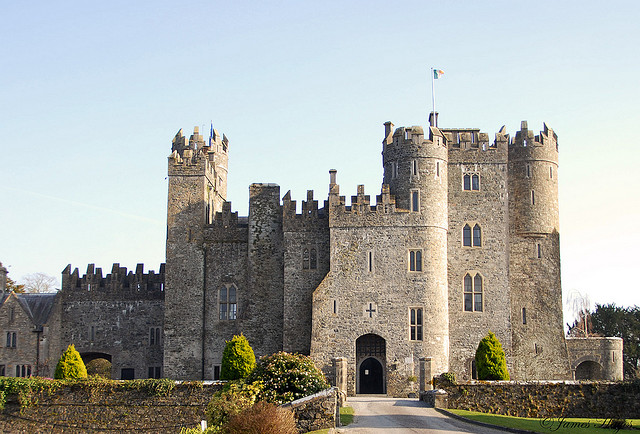
Today’s ghost story is from Ireland. It was retold by St. John D. Seymour and Harry L. Neligan in True Irish Ghost Stories, 1914. You can purchase the book on Amazon.
Gerald Fitzgerald the Younger, 11th Earl of Kildare, died on the November 16, 1585. (Hey – November 16 is my birthday!) His body was buried in St. Brigid’s Cathedral in Kildare. He was known as “the Wizard Earl” because he was believed to practice black magic and could transform himself into a bird or animal when he choice. His supernatural powers were so notorious he had become the terror of the countryside.
His wife, the Countess, had long wanted to see some proof of his skill, and had frequently begged him to transform himself before her, but he had refused to do so, stating that if he did and she became afraid, he would be taken from her and she would never see him again. Still she persisted, and at last he said agreed on condition that she should first of all undergo three (that magical number) trials to test her courage. she said she would. For the first test, the Earl caused the river Greese, which flowed by the castle walls, to overflow its banks and flood the banquet hall in which the Earl and Countess were sitting. She showed no fear, and at the Earl’s command the river receded to its normal course. At the second trial a huge eel-like monster appeared, which entered by one of the windows, crawled about among the furniture of the banquet hall, and finally coiled itself round the body of the Countess. Still she showed no fear, and at a nod from the Earl the animal uncoiled itself and disappeared. In the third trial, a friend of the Countess, long since dead, entered the room, and passing slowly by her went out at the other end. The Countess showed not the slightest sign of fear.
The Earl was satisfied that he could place his fate in his wife’s keeping, but he again warned her of the danger if she lost her presence of mind while he was in another shape. He then turned himself into a black bird, flew about the room, and perching on the Countess’s shoulder began to sing. Suddenly a black cat appeared from under a chest, and made a spring at the bird; in an agony of fear for its safety the Countess threw up her arms to protect it and fainted. When she awoke, she was alone, the bird and the cat had disappeared, and she never saw the Earl again.
Legend says that the Earl was never seen again, but some historians believe the Earl lived out the remainder of his life in semi-captivity in London only returning back to Ireland for burial in 1585.
It is said that the Earl and his knights lie in an enchanted sleep, with their horses beside them, in a cave under the Rath on the hill of Mullaghmast, which stands five miles to the north of Kilkea Castle. Once in seven years they are allowed to issue forth; they gallop round the Curragh plain, then across country to Kilkea Castle, where they re-enter the haunted wing, and then return to the Rath of Mullaghmast. The Earl is easily recognised as he is mounted on a white charger shod with silver shoes; when these shoes are worn out the enchantment will be broken, and he will issue forth, drive the foes of Ireland from the land, and reign for a seven times seven number of years over the vast estates of his ancestors.
Shortly before 1898 he was seen on the Curragh by a blacksmith who was crossing it from Athgarvan to Kildare. A fairy blast overtook him, and he had just time to say, “God speed ye Gentlemen” to the invisible “Good People,” when he heard horses galloping up behind him. Pulling to one side of the road he looked back and was terrified at seeing a troop of knights, fully armed, led by one on a white horse. The leader halted his men, and riding up to the blacksmith asked him to examine his horse’s shoes. Almost helpless from fear, he stumbled out of the cart and looked at each shoe, which was of silver, and then informed the knight that all the nails were in fine shape. The knight thanked him, rejoined his troop, and galloped off. The blacksmith hastened on to Kildare, where he entered a pub, ordered a whisky, and drank it. He told the men that were present what had happened to him on the Curragh. One old man who had listened to him said, “By the mortial! man, ye are after seeing ‘Gerod Earla.'” Gerod Earla, or Earl Gerald, is the name by which the Wizard Earl is known by the peasants.
I guess we’ve actually got two ghosts in this short tale, the one presented to the countess and the Earl himself. I feel a little bad for the Earl, wizard though he was. The Countess wasn’t afraid of him, but afraid the cat would hurt him, which to me is entirely different. I guess it made no difference to the magic though.
Thursday’s Tales is a weekly event here at Carol’s Notebook. Fairy tales, folktales, tall tales, even re-tellings, I love them all. Feel free to join in and leave your link the comments.

Cool, I had not heard this one